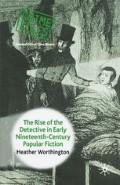Abstract
A broadside is an unfolded sheet of paper with printed matter on one side only—a proclamation, poster, handbill, or ballad-sheet. The form had been in existence since the sixteenth century, when the new printing technology made possible the production of almost instantaneous accounts of matters of public interest, functioning as an early form of journalism. The main function of ballads was to act as proto-newspapers, informing primarily the literate and illiterate lower classes of public events such as earthquakes, wars, murders, freaks of nature, and supernatural happenings. In the sixteenth century ballads concerned with criminality were the most popular, and in the nineteenth century criminal narratives had maintained, indeed increased, this popularity. Henry Mayhew, in his exhaustive exploration of the condition and earnings of the population of the metropolis London Labour and the London Poor (1851), estimated that ‘Street-sellers of Executions &c’ earned on average ‘9s. weekly’ each, making the sum ‘expended yearly, on executions, fires, deaths &c, in London £3, 276’. This sum is exceeded only by the sales of popular ballads intended for singing (£4680), and of books (£5733).1 Mayhew was writing in 1851 when literacy in the population had increased, and when a proliferation of cheap literature in periodical, book, and newspaper forms was widely available, but broadsides, particularly those concerned with the crime of murder and its punishment by execution, appeared to suffer no ill-effects from the competition.
Access this chapter
Tax calculation will be finalised at checkout
Purchases are for personal use only
Preview
Unable to display preview. Download preview PDF.
Notes
Henry Mayhew, London Labour and the London Poor Vol. 1: The London Street Folk (London: Frank Cass, 1967 [1851]), pp. 308–309.
Michael Hughes, ‘Foreword’ to Charles Hindley’s Curiosities of Street Literature (London: Seven Dials Press, 1969), p. 11. The original text by Hindley was published by Reeves and Turner of London in 1871.
Thomas W. Laqueur, ‘Crowds, Carnival and the State in English Executions, 1604–1868’, in The First Modern Society: Essays in English History in Honour of Lawrence Stone, eds, A. L. Beier, D. Cannadine and James M. Rosenheim (Cambridge: Cambridge University Press, 1989), pp. 305–355, p. 309.
V. A. C. Gatrell, The Hanging Tree: Execution and the English People (Oxford: Oxford University Press, 1994), p. 94.
October 1861, p. 399. Cited in Victor Neuberg, Popular Literature: A History and Guide (Harmondsworth: Penguin, 1997), p. 142.
Richard Altick, Victorian Studies in Scarlet (London: Dent, 1972), p. 42.
Leslie Shepard, The History of Street Literature (Newton Abbot: David and Charles, 1973), p. 193.
Martin J. Wiener, Reconstructing the Criminal: Culture, Law and Policy in England, 1830–1914 (Cambridge: Cambridge University Press, 1994 [1990]), p. 96.
For an acount of the Newgate novel see Keith Hollingsworth, The Newgate Novel 1830–47: Bulwer, Ainsworth, Dickens and Thackeray (Detroit: Wayne State University Press, 1963).
De Quincey, ‘On Murder Considered as One of the Fine Arts’, Blackwood’s Edinburgh Magazine 21:122 (February 1827), pp. 199–213.
This essay was first published in the London Magazine (October 1823) under the series title of ‘Notes from the Pocket-Book of a Late Opium-Eater’. See also David Masson, ed., The Collected Writings of Thomas De Quincey Vol. X: Literary Theory and Criticism (Edinburgh: Adam and Charles Black, 1890), pp. 389–394.
De Quincey, ‘On Murder Considered as One of the Fine Arts’, in The Collected Works of Thomas De Quincey Vol. XIII: Tales and Prose Phantasies, ed., David Masson (Edinburgh: Adam and Charles Black, 1890), p. 9.
A. S. Plumtree, ‘The Artist as Murderer’, in Thomas De Quincey Bicentenary Studies, ed., Robert Lance Snyder (Norman and London: University of Oklahoma Press, 1985), pp. 140–163, p. 155.
De Quincey, ‘Murder Considered as One of the Fine Arts’, Blackwood’s Edinburgh Magazine 46:289 (November 1839), pp. 661–668.
Grevel Lindop, The Opium-Eater: A Life of Thomas De Quincey (London: Dent, 1981), pp. 378–379.
Lennard Davis, Factual Fictions: The Origins of the English Novel (Philadelphia: University of Pennsylvania Press, 1996 [1983]), p. 48.
‘Introduction’, Robert Morrison and Chris Baldick, Tales of Terror from Blackwood’s Magazine (Oxford and New York: Oxford University Press, 1995), pp. vii-xxi, p. xv.
Alvin Sullivan, ed., British Literary Magazines, Vol. II: The Romantic Age 1789–1836 (Westport, Conn, and London: Greenwood Press, 1983), p. 45.
Blackwood’s Edinburgh Magazine was ‘a 2s. 6d monthly’ publication, a price which placed it beyond the reach of much of the population. See Scott Bennett, ‘Revolutions in Thought: Serial Publication and the Mass Market for Reading’, in The Victorian Press: Samples and Soundings, eds, Joanne Shattock and Michael Wolff (Leicester: Leicester University Press, 1982), pp. 225–260, pp. 235–236.
Robert D. Mayo, ‘Gothic Romance in the Magazines’, Publications of the Modern Language Association 65 (1950), pp. 762–789, p. 764.
Daniel Keyte Sandford, ‘A Night in the Catacombs’, Blackwood’s Edinburgh Magazine 4:19 (1818), pp. 19–23.
William Maginn, ‘The Man in the Bell’, Blackwood’s Edinburgh Magazine 10:57 ( 1821), pp. 373–375.
John Galt, ‘The Buried Alive’, Blackwood’s Edinburgh Magazine 10:56 (October 1821), pp. 262–264,
Henry Thomson, ‘Le Revenant’, Blackwood’s Edinburgh Magazine 23:124 (April 1827), pp. 409–416.
Robert MacNish, ‘An Execution in Paris’, Blackwood’s Edinburgh Magazine 24:146 (December 1828), pp. 785–788.
John Wilson, ‘Extracts from Gosschen’s Diary’, Blackwood’s Edinburgh Magazine 3:17 (August 1818), pp. 596–598.
Letter from Lamb to William Hone. See Charles and Mary Lamb, Letters, ed., E. V. Lucas (London, 1912), II, p. 773. Cited in Hollingsworth, The Newgate Novel, p. 59.
Stephen Knight, Form and Ideology in Crime Fiction (Bloomington: Indiana University Press, 1980), p. 11.
John Wilson, ‘Expiation’, Blackwood’s Edinburgh Magazine 28:172 (October 1830), pp. 628–643.
Author information
Authors and Affiliations
Copyright information
© 2005 Heather Worthington
About this chapter
Cite this chapter
Worthington, H. (2005). Criminal Narratives: Textualising Crime. In: The Rise of the Detective in Early Nineteenth-Century Popular Fiction. Crime Files Series. Palgrave Macmillan, London. https://doi.org/10.1057/9780230506282_2
Download citation
DOI: https://doi.org/10.1057/9780230506282_2
Publisher Name: Palgrave Macmillan, London
Print ISBN: 978-1-349-52042-8
Online ISBN: 978-0-230-50628-2
eBook Packages: Palgrave Literature & Performing Arts CollectionLiterature, Cultural and Media Studies (R0)

